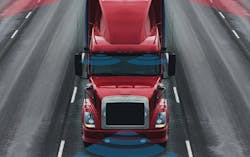This is the second part of a five-part feature on how cameras and video are changing fleets and drivers as a new decade dawns. Read Part 1 and Part 2.
Advances in fleet safety technologies will bring a variety of improvements this decade, according to T.J. Thomas, director of marketing and customer solutions for the control group at Bendix Commercial Vehicle Systems.
“You’re going to see the camera technology improve. You’re going to see better images. You’re going to see faster processing. All those things are going to rise,” he said.
This will happen through several technologies working together to create more information and improve fleet operations.
“When those next technologies do come out, they get translated into our industry a little quicker than before because the ROI is already proven,” Thomas said.
Nussbaum Transportation has been pilot testing computer vision, which is one of the next big things in fleet camera technology.
“You can start measuring habits with that beyond just the camera triggering and somebody reviewing it,” said Jeremy Stickling, the chief administrative officer for Nussbaum. “The camera’s telling you what’s going on — this person came into our lane, and we reacted slowly, or we reacted right. It can catch good stuff too.
“That’s probably where I get more excited — because sometimes when you make a truck movement, it’s for a good reason. It’s skilled driving,” he added. “When you start adding computer vision to capture that stuff, we can start using it for positive feedback to not just point out you followed too close here, but this person came over in front of you, you did all these right things, and you reacted very well. This deserves a thumbs up.”
But computer vision is still a work in progress, according to SmartDrive CEO Steve Mitgang.
“I think the secret is going to come out that these things are partially great,” he said. “We see working with technology companies, that 10 to 20% of the time, they’re wrong. I can show any fleet today a collection of videos where pedestrian detection is going off — and there’s no pedestrian. I can show them dozens and dozens of videos with collision-mitigation systems literally bringing a vehicle to a stop — and there’s no vehicle to the side or in front of them.”
And until computer vision and other safety systems are perfected, it might not change the driver’s behavior how a fleet manager hopes.
“The problem is that if you’re alerting the driver and the driver knows that something is wrong, then the driver stops paying attention,” Mitgang pointed out. “That’s the dirty secret that’s going to start coming out.”
This is the second part of a five-part feature on how cameras and video are changing fleets and drivers as a new decade dawns. Read Part 1 and Part 2.
About the Author
Josh Fisher
Editor-in-Chief
Editor-in-Chief Josh Fisher has been with FleetOwner since 2017. He covers everything from modern fleet management to operational efficiency, artificial intelligence, autonomous trucking, alternative fuels and powertrains, regulations, and emerging transportation technology. Based in Maryland, he writes the Lane Shift Ahead column about the changing North American transportation landscape.

